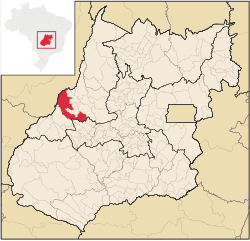Jussara
| Jussara | |
|---|---|
| Municipality | |
 Location in Goiás state |
|
| Location in Brazil | |
| Coordinates: 15°51′51″S 50°51′08″W / 15.86417°S 50.85222°WCoordinates: 15°51′51″S 50°51′08″W / 15.86417°S 50.85222°W | |
| Country |
|
| Region | Central-West Region |
| State | Goiás |
| Microregion | Rio Vermelho Microregion |
| Area | |
| • Total | 4,092.4 km2 (1,580.1 sq mi) |
| Elevation | 317 m (1,040 ft) |
| Population (2007) | |
| • Total | 18,814 |
| • Density | 4.6/km2 (12/sq mi) |
| Time zone | BRT/BRST (UTC-3/-2) |
| Postal code | 76270-000 |
Jussara is a municipality in Goiás state, Brazil. Jussara is a major producer of cattle for the beef market.
Jussara is located in the region of the Vale do Araguaia, 222 kilometers from the state capital of Goiânia. Highway communications are made with Goiânia by GO-060 / Trindade, Goiás / Claudinápolis / GO-326 / Anicuns / Sanclerlândia / Novo Brasil / GO-324. Sepin
The town began as the Agricultural Colony of Água Limpa, belonging to the city of Goiás. In 1950 the name was changed to Jussara in tribute to Jussara Amorim, the first woman from Goiás to be elected Miss Brasil. In 1958 it was dismembered from Goiás and elevated to a municipality.
Today it borders the municipalities of Britânia, Montes Claros de Goiás, Fazenda Nova, Santa Fé de Goiás, Novo Brasil and Itapirapuã and is crossed by highways BR-070 and by GOs 324 and 418.
The climate is typically tropical with high temperatures, between 35 and 38 degrees. The city forms part of the Amazon basin, being made up of the Samambaia, Água Limpa, Araguaia, Molha Biscoito and Palmeira rivers. Its vegetation is characterized by forest and cerrado. The tourist area takes in the area of the Araguaia River, with its natural environment, beaches, flora and fauna.
The economy is based on modest commerce, public employment, small transformation industries, cattle raising, and agriculture. There is an industrial district and a dairy.
...
Wikipedia

